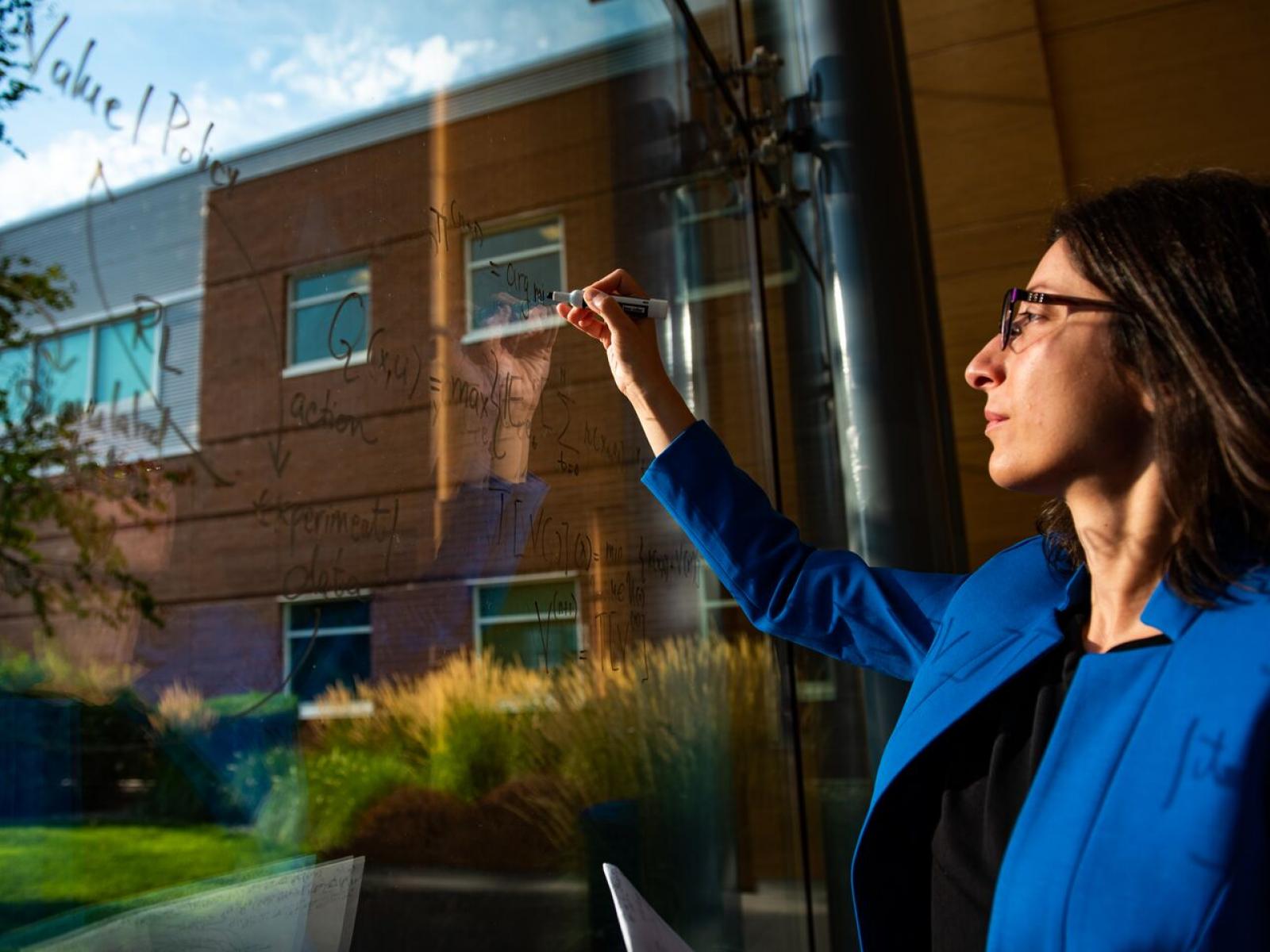Draguna Vrabie Gives a Big-Picture Talk at Autonomous Discovery Workshop
PNNL data scientist explains autonomous learning at virtual workshop

PNNL data scientist Draguna Vrabie presented on autonomous control systems and learning.
(Photo by Andrea Starr | Pacific Northwest National Laboratory)
Draguna Vrabie, a data scientist in the Advanced Computing, Mathematics, and Data Division at Pacific Northwest National Laboratory (PNNL) with expertise in autonomous systems and computer engineering, was invited to give the first talk at the virtual workshop on Autonomous Discovery in Science and Engineering.
Sponsored by Lawrence Berkeley National Laboratory’s CAMERA, The Center for Advanced Mathematics for Energy Research Applications, the three-day virtual workshop in April 2021 featured more than a dozen 30-minute talks, moderated breakout sessions with parallel tracks, and hands-on tutorials.
The workshop was designed to foster collaboration between scientists in the fields of artificial intelligence (AI) and machine learning (ML), to share recent developments, accelerate innovation, and create a community around autonomous discovery.
Atypical background provides a unique perspective
Vrabie’s background is in control systems engineering, a technical expertise that combines applied mathematics and computer science with design systems that exhibit desired behaviors in control environments. For more than a decade, Vrabie has been applying her theoretical knowledge to a diverse set of application domains including high-performance buildings, power grids, power electronics, jet engines, and autonomous robotics.
The workshop organizers asked Vrabie to be the first speaker at the workshop because of her extensive knowledge of autonomous systems, computing, and control theory combined with years of real-world domain knowledge experience.
What is autonomous discovery?
Vrabie describes autonomous discovery as an ML-based technique that is like reinforcement learning, where a computer can look at a problem, examine data, and determine what experiments to perform next to increase knowledge. “It’s a combination of machine learning methods such as active learning, few-shot learning (making predictions based on limited data sets), representation learning, computational environments that allow for simulation-based experimentation, and automated robotic platforms,” she said.
The first day of the workshop was designed to introduce general concepts and showcase the rapidly evolving AI/ML theoretical and computational methods, math, and algorithms being developed to enable autonomous discovery. Vrabie was the first of three presenters to give a big-picture presentation, during which she introduced a high-level view of modern control systems and showcased the unique ML capabilities developed at PNNL.
In her presentation, Vrabie provided an overview of autonomous control systems and learning, explaining how she studies scientific experiments from a computational perspective. She described how she uses her background in robotics to bring automation to the materials design process, particularly the time-consuming and labor-intensive synthesis and processing steps.
Vrabie and her colleagues at PNNL study automation and robotics to determine how to make the experiments faster and more efficient without requiring scientists to be involved in every step. The goal is to have the computers automate the manual tasks that currently only scientists can do.
“We’re trying to transform the scientific process into something that allows us to synthesize good materials and chemistries thousands of times faster with fewer experiments. We can begin this process by collecting data from experiments over the past 20 years and leveraging the past results,” said Vrabie.
A data-driven predictive control approach
Control systems operate large, one-of-a-kind instruments at user facilities operated by the Department of Energy's (DOE’s) Office of Science, such as the Environmental Molecular Sciences Laboratory at PNNL, the Fermi National Accelerator Laboratory, and the Spallation Neutron Source at Oak Ridge National Laboratory.
During her talk, Vrabie explained that control systems are critical in operating the unique instruments found at DOE user facilities. She emphasized that ML, decision-making, and optimization are key to automation and can be used to improve the overall performance and energy efficiency of the systems.
Vrabie’s current research focuses on increasing the autonomy of the instruments and improving the operation of the underlying system to accelerate scientific discovery.
On the third day of the workshop, PNNL’s Steven Spurgeon, a materials scientist in the Energy and Environment Directorate, presented on “Progress Toward Rapid, Statistical Scanning Transmission Electron Microscopy” in a breakout session.
CAMERA is jointly funded by DOE’s Office of Advanced Scientific Computing Research, and the Office of Basic Energy Sciences, both within the DOE’s Office of Science. The workshop organizers, led by a research scientist at CAMERA, assembled highlights from the presentations and reports from the speakers, which are now available on the workshop website.
Published: September 21, 2021